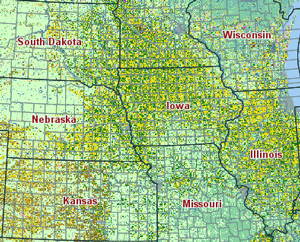 To provide easier access to geospatial satellite products, the U.S. Department of Agriculture’s National Agricultural Statistics Service (NASS) has just launched CropScape, a new cropland exploring service.
To provide easier access to geospatial satellite products, the U.S. Department of Agriculture’s National Agricultural Statistics Service (NASS) has just launched CropScape, a new cropland exploring service.
CropScape provides data users access to a variety of new resources and information, including the 2010 cropland data layer (CDL) just released in conjunction with CropScape. The new service offers advanced tools such as interactive visualization, web-based data dissemination and geospatial queries and automated data delivery to systems such as Google Earth.
“CropScape delivers data visualization tools directly into the hands of the agricultural community without the need for specialized expertise, GIS software or high-end computers,” said Mark Harris, NASS Research and Development Division director. “This information can be used for addressing issues related to agricultural sustainability, land cover monitoring, biodiversity and extreme events such as flooding, drought and hail storm assessment.”
NASS produced the 2010 CDL using satellite image observations at 30-meter (0.22 acres per pixel) resolution and collected from the Resourcesat-1 Advanced Wide Field Sensor (AWiFS) and Landsat Thematic Mapper. The collection of images was categorized using on-the-ground farm information including field location, crop type, elevation, tree canopy and urban infrastructure. All prior CDL products dating back to 1997 are also hosted by CropScape.
CropScape was developed in cooperation with the Center for Spatial Information Science and Systems at George Mason University, Fairfax, Va. The research and development of CropScape and the NASS partnership with George Mason University reflect NASS’s continued commitment to improve U.S. agricultural production, sustainability and food security.
Check it out here.
